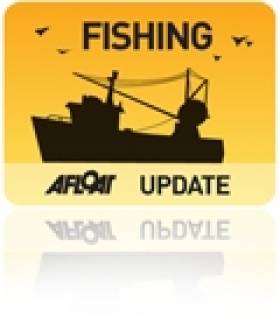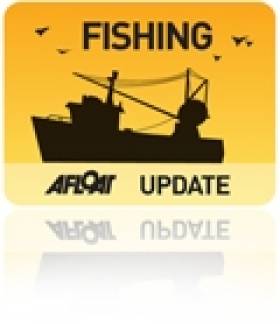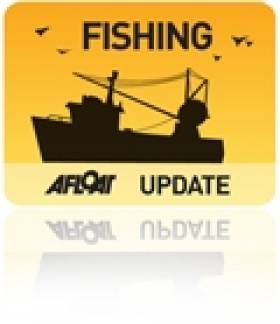Displaying items by tag: boarfish
Invitation To Tender For Boarfish Survey Vessel Charter
#Fishing - The Marine Institute is inviting tenders for the supply of a commercial fishing vessel to conduct a boarfish acoustic survey in ICES divisions VII b, c, g, h, j & k (west of Ireland, Celtic Sea and northern Biscay).
The vessel would be chartered for a period of 21 days to survey spawning aggregations of boarfish – a big seller for Ireland in the Chinese market – using hydro-acoustic techniques.
Vessels are invited to tender on the basis of their ability to undertake the survey schedule. This comprises following a pre-determined cruise track in the order of 3,200 nautical miles carried out over 21 days with 20hr operations (4am-midnight) and with directed trawl stations on fish schools of interest as and when required.
A single pelagic midwater trawl with a vertical opening of greater than 40m and contain a 20mm codend liner and/or sprat brailer will be a requirement for the survey. A liner can be provided if required but all other associated fishing equipment must be provided by the vessel.
The survey will be timed to coincide with the southerly end point of the RV Celtic Explorer on 10 July 2015 and this survey will act as a continuation. It is therefore essential that the charter vessel is out on the water and ready to begin surveying no later than midnight on 9 July 2015.
Detailed information of the track and survey plan will be provided by the Marine Institute. The successful applicant will be selected based on technical suitability, cost of charter, pelagic fishing track record and previous experience in scientific research and surveys.
The closing date for tenders is this Friday 29 May 2015 at 12 noon. Full details of the tender are available in a PDF to read or download HERE.
Coveney Welcomes Record Irish Presence At Chinese Seafood Expo
#Seafood - Following a meeting today (5 November) with Chinese Vice Minister Niu Dun, who has responsibility for fisheries, Marine Minister Simon Coveney opened the largest ever Irish pavilion at the China Seafood & Fisheries Expo, which takes place in Qingdao this week.
Speaking at the event, Minister Coveney said: “Ireland has some of the finest seafood in the world, with a superior offering that is sustainably harvested from the pure, clean waters of the Atlantic Ocean.
"Business development and trade show events such as these are invaluable in building awareness of our high quality produce to an influential, targeted trade audience.
"China continues to be a growing market for Irish seafood and with exports increasing by over 300% since 2011 to reach €18 million in 2013. This strong trend in Irish exports to the region is continuing in 2014 with sales for the first 6 months up 56% compared to the same period last year.”
Organised by Bord Bia, Ireland’s stand will include representatives from a record 11 Irish seafood companies between today and Friday 7 November at the largest trade show in China, with more than 25,000 visitors expected from over 100 countries.
In 2013, China's seafood trade surpassed €20 billion in value, cementing its position as the world's leading seafood trading country. Growing incomes and increased urbanisation have helped fuel a massive growth in demand for imported seafood.
China currently accounts for one quarter of the world’s seafood consumption, and the United Nation’s FAO projects that China will need an extra 16 million tonnes of seafood by 2020 to meet growing demand.
Minister Coveney added: “The strong Irish representation from both the pelagic and shellfish sectors in Qingdao today demonstrates the commitment of both industry and government to deepen ties and strengthen relationships with our Chinese customers.”
Traditionally, the Chinese market has been important for the Irish seafood industry predominantly for the sale of pelagic species such as boarfish, which was launched in China this year after a successful presentation at the 2013 expo.
However, in the last three years, significant effort has been invested by Irish processors and Bord Bia to identify and develop opportunities for premium shellfish in this growing market for seafood, notably for shellfish such as live and processed brown crab, langoustines, scallops and razor fish.
Bord Bia chief executive Aidan Cotter said: “The strong and sustained growth in exports in recent years demonstrates the continued success of Ireland’s leading shellfish processors in penetrating this valuable market. Exports of shellfish to China, for example, increased in value by over 200% between 2012 and 2013, while exports to Hong Kong increased by 117% during the same period.
"Bord Bia has ambitious plans to further grow the share of Irish seafood into China and has a number of programmes in place to assist Irish seafood processors in identifying, profiling and targeting new customers that are willing to pay a premium for quality seafood from Ireland.”
Through its trade development programme, Bord Bia says it has been very successful in encouraging high-end retail and foodservice Chinese customers to visit Ireland to meet with Irish seafood processors on a one-to-one basis.
These itineraries have been described as very effective in generating new business for the sector, providing Irish companies with an excellent opportunity to showcase their processing facilities and also allowing the customers to see first hand the world-class environment in which Irish seafood is produced. These visits can provide a guarantee to Chinese customers on traceability, sustainability and food safety, all key issues of growing concern to the Chinese consumer.
“Irish seafood has enjoyed ongoing and increasing market access to China," said Dr Susan Steel, chair of the Sea-Fisheries Protection Authority. "International trade in food is based upon a reciprocated trust in food safety systems. The Sea-Fisheries Protection Authority, as regulator, verifies the safety and sustainability of Irish seafood and we welcome this Chinese confidence in the robustness of the assurance systems we implement."
During the last three years, Bord Bia has welcomed more than 25 Asian customers to Ireland on customised itineraries. Many of these visits have delivered new business for Irish seafood processors, and in March 2015, as part of its Marketplace International event, Bord Bia will host an additional 17 Asian customers on a visit to Ireland.
The buyers will meet with Ireland’s leading seafood processors, and Bord Bia has set a target of securing €7 million worth of new business for the seafood sector arising from this event.
In September 2013, over €4 million worth of new business was secured with a range of Asian seafood customers who travelled to Ireland to attend Bord Bia’s Global Sustainability Conference.
Going into 2015, to build on the momentum and further increase exports of premium Irish seafood to China, Bord Bia will concentrate its promotional efforts on increasing awareness of new species from Ireland such as brown crab and Irish prawns.
Targeting premium chefs, media and key opinion-formers, Bord Bia will co-ordinate a series of cookery demonstrations in Beijing and Shanghai, focusing on introducing recipes for these species that are new to the Chinese market.
The campaign will assist the Irish processing sector to sell in their ranges to distributors servicing the premium restaurants and hotels in these two key locations. In addition, Chinese consumers will be educated and informed through a comprehensive programme of in-store tastings with a number of supermarket retail chains.
Mr. Sean Connick, T.D. Minister of State at the Department of Agriculture, Fisheries and Food welcomed the agreement reached after two days of talks in Brussels on 2011 quotas for the Irish fishing fleet.
The final agreement will deliver whitefish quotas worth some €116 million, including the protection of Ireland's €54 million prawn fishery. There will be a 10% increase in quota for Ireland's €75 million mackerel industry and a two thirds share, worth approximately €4 million, for Irish fishermen of the new boarfish industry.
Speaking at the end of the negotiations in the early hours of Wednesday (16 December), the Minister said
"The negotiations have been particularly challenging this year with the European Commission proposing cuts across many stocks of commercial importance for Ireland. Consulting with our fishing industry and NGOs, working with other Member States and concentrating on the scientific evidence, was, I believe key to securing a balanced sustainable package."
"This package will help underpin the economic future of our costal communities."
There will be 15% increase in haddock and whiting stocks in the Celtic Sea. While for the cod stocks off the North West and the Irish Sea, the quotas will be reduced by 25% in line with the Recovery Plan for these stocks. For Celtic Sea cod, the current quota level has been maintained for 2011 on the basis of new survey results from the State's Research Vessel "Celtic Explorer".
Minister Connick commented "By introducing new information on Celtic Sea cod, I secured agreement that the current level of TAC will continue into 2011, and may be increased during the year if the new survey results are confirmed by the scientists. However, given the poor state of cod stocks off the North West and in the Irish Sea, cuts were necessary".
Commenting on the 3% reduction in the prawn quota, the Minister said "Prawns are a very important fishery all around our coast. It is the most valuable catch for the Irish whitefish fleet worth €54 million. While the Commission originally proposed a 17% cut, I secured just a 3% decrease in the quota on the basis of a strong scientific case."
The quota for mackerel will be increased by 10%, and should be worth up to €75m in 2011. This is the most important fishery for the North West fleet based in Killybegs and is also important for the South West multi purpose fleet, supporting processing jobs in the coastal communities.
There were also increases in the quota for Celtic Sea herring of 30%, although there were cuts in the North West stock reflecting concerns about the state of those stocks.
Finally, Ireland secured the largest share in an important new fishery for boarfish that will be worth just under €4 million in 2011. The Irish fishing industry has been working with the scientific community to develop a management plan for boarfish, a mid-water shoaling species, now found in large volumes off the South West coast. The agreement reached in Brussels provides for a total allowable catch of some 33,000 tonnes, with two thirds going to Ireland.
Minister Connick commented "In an example of a successful investment in scientific research by industry, we have opened up a new fishery and secured the major stake in that industry. This ensures a new revenue stream for Irish industry into the future. We believe we can now develop a significant and sustainable fishery on this stock, in which we will continue to hold the largest share".

























